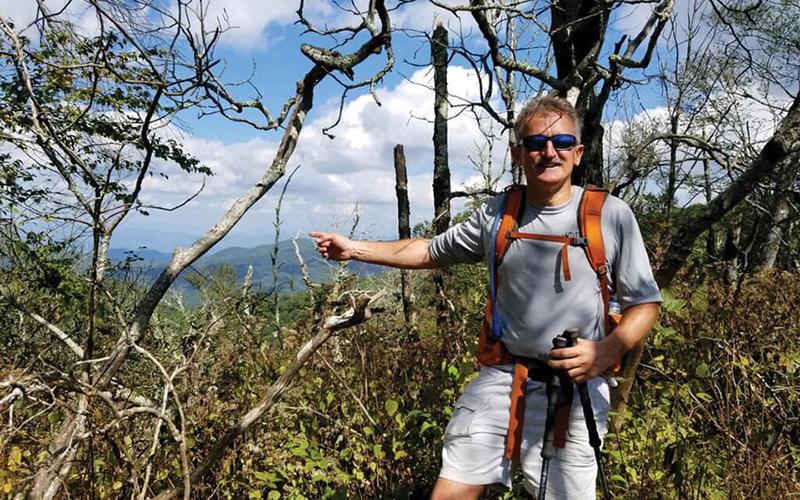Stecoah – “Blindness has afforded me the opportunity to experience the best parts of humanity,” said Navy veteran and Blinded Veterans Association member Lonnie Bedwell.
Fresh off Day 5 of a 91-mile section of the Appalachian Trail, hikers and their support team enjoyed Graham County hospitality Saturday as they tucked into a spaghetti casserole at Stecoah Valley Cultural Arts Center before tent-camping on the center’s campus.
“So many people are just so kind,” said Bedwell. “People provide light in the darkness. It’s so important to let people know that believing in us and providing us with this opportunity; it’s huge. It doesn’t just change our lives but also our families’ lives and the people in the community.”
The Blind Appalachian Trail team reached Stecoah after launching their section hike in Georgia on Sept. 24. A 6-day hike is just one of many adventures for Bedwell, the first blind person to negotiate the entire Colorado River in a kayak solo.
He also climbs mountains, snow skis, and builds houses.
“I wouldn’t have done any of these things if I hadn’t lost my sight,” said Bedwell.
His next adventure will be climbing the highest peak in South America in January.
Army veteran and BVA Sergeant-at-Arms Kennan Horn has an adventure of his own planned for January; serving on the vision research panel in Washington, D.C..
“When you start to lose your vision, you can choose to sit on your butt or get up and find other things that challenge you,” Horn said.
When Horn lost his sight, he “didn’t know any other blind guys, definitely no blinded veterans,” but three years ago he found the BVA’s Operation Peer Support and the fellowship of fellow blinded vets. “That personal connection is priceless,” he said.
Horn recently gained a new kind of connection with his first guide dog, a yellow lab/golden retriever mix named Dervish.
“I miss him like he’s a newborn baby,” said Horn, who describes having a guide dog as “totally transformative.”
For Horn, the toughest part of working with the BVA is knowing that there are blinded veterans out there who have not been reached.
“We have to wait for them to reach out, to ask for help, and that’s hard,” said Horn.
Daniel Wallace, Army vet and National Secretary of the BVA, wants every visually impaired person to realize that “there is a future without sight.”
Wallace explained that last year’s hike was 75 miles, a distance that commemorated the 75th anniversary of D-Day. “These hikes have three main goals,” Wallace said. “We want to show the public what blinded vets are capable of, inspire fellow members, and help find newly blinded vets and let them know that there’s something better.”
Of course, any group hiking the AT requires planning, logistics, and back-up, and this is where folks like Army veteran Dick Evans step in. “When I heard that blind vets needed help on the AT, I said, ‘What do you need us to do?’”
Evans, who lives in Tuskegee, helped with fundraising as well as organizing and stressed that Beth Fields, director of the Stecoah center, was “extremely supportive. In fact, all of Graham County was extremely supportive.”
This year’s hike concluded at Fontana Campground, a site chosen so that the hikers and their support team could celebrate in true military fashion, with plenty of cold beers.
“A lot of people in small towns don’t get to see how they affect the outside world,” said Horn, “but a lot of local people around here donated to support this hike, and each and every one of us is deeply appreciate. That’s a beautiful thing.”
Blind Appalachian Trail maintains a Facebook page, and the Blinded Veterans Association may be reached at bva.org.

